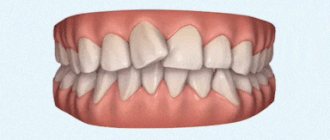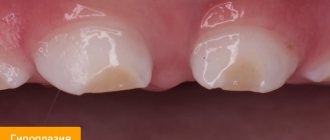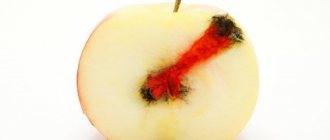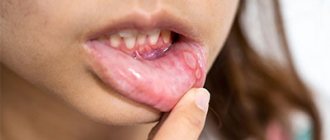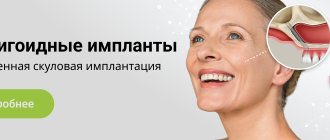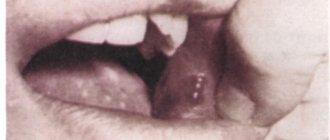Signs Causes Types Complications Diagnostics Treatment Methods Prevention Doctors Work
Malocclusion occurs in different forms. One of them is an open bite. It is recorded quite rarely - up to 2% of patients have such an anomaly. In 12% of children under one year of age, improper closure is noted, by 6 years - 5.6%, and in adults the percentage is very small - 1.8 - 2%.
What is an open bite?
An open bite is a malposition of the dentition in which the front or lateral teeth of the upper and lower jaws do not meet. In this case, not only physiological disorders are observed, but also functional ones. Due to the lack of bite contact, a person cannot chew food well, as a result of which it enters other organs of the gastrointestinal tract in this form. This is why people with open bites often suffer from digestive problems.
This malocclusion can occur in both children and adults. In the absence of adequate treatment, its severity may worsen, and over the years it will become more and more difficult to correct it.
Diagnosis of the disease
Only an orthodontist can determine the type of dental anomaly. The doctor will make an accurate diagnosis and, based on this, prescribe the necessary treatment. Diagnostic measures for suspected open bite include:
- External examination of the oral cavity and dentition.
- Measurements of jaw and dentition parameters using special instruments.
- X-ray of the jaws.
Important! If during the examination the dentist identifies other disorders, the patient will also be referred to doctors of other specialties. For example, this could be a speech therapist (for speech disorders), an otolaryngologist (for nasal breathing problems) and other doctors. It is important not only to correct the bite itself, but also to eliminate associated pathologies and disorders.
Causes
The causes of open bite can be divided into prenatal and postnatal. The first group includes the following:
- various unfavorable hereditary factors;
- infectious and somatic diseases suffered by the woman;
- bad habits and unbalanced diet of a pregnant woman;
- severe toxicosis.
All these factors can influence the process of bite formation in primary and permanent teeth. In this case, more serious concomitant pathologies may develop, such as cleft lip, deformation of the entire jaw, etc. Therefore, when identifying any malocclusion, it is important to conduct a comprehensive examination.
An open bite may develop in the postnatal period due to internal or external factors. In the first case, we are talking about a lack of certain microelements in the body, as well as a violation of metabolic processes.
Another common cause of malocclusion is that the child has problems with nasal breathing. In this regard, he begins to systematically breathe through his mouth, getting used to keeping it open. If parents notice such features, they should check the structure of the nasopharynx, especially the nasal septum, as soon as possible and begin treatment. Otherwise, the child may develop not only an open bite, but also other jaw pathologies.
The group of external factors includes the following:
- the child’s habit of biting nails or other foreign objects, for example, toys, pen caps, etc.;
- thumb sucking during the eruption of baby teeth;
- frequent protruding of the tongue between the teeth with the mouth open.
Often in these cases, the very form of the malocclusion begins to resemble the outline of the object that the child held in the mouth - a finger, a toy, etc.
Reasons for development
The reasons that contribute to the formation of an open bite can be identified as follows:
- burdened heredity;
- diseases suffered by the mother during pregnancy, which negatively affect the formation of the musculoskeletal system in the fetus;
- atypical formation of tooth buds in the fetus in the womb of unknown etiology;
- rickets suffered in infancy;
- pathologies of the development of the endocrine system;
- the presence of bad habits in the child, such as thumb sucking, toys, etc.
- the child's head is constantly thrown back during sleep;
- cleft palate and/or alveolar ridge;
- injuries.
Reasons for the formation of rachitic open bite:
- lack of sun exposure;
- unadapted nutrition for babies, which does not contain the required amount of vitamin D. This may include vegetarian dishes, unbalanced milk and non-dairy formulas;
- aggravating perinatal factors - placental insufficiency or prematurity;
- lack of motor activity in infancy. This also includes the lack of preventative massage and exercise;
- intestinal dysbiosis and, as a result, impaired digestion and evacuation of food;
- long-term anticonvulsant therapy carried out using phenobarbital (Luminal), which significantly accelerates the metabolism and excretion of active forms of ergocalciferol (vitamin D);
- metabolic disorders, such as cystic fibrosis;
- liver and kidney diseases that contribute to increased excretion of vitamin D;
- abnormalities in calcium, phosphorus and ergocalciferol metabolism;
- unfavorable environmental conditions, in particular, high levels of lead, zinc and strontium in water and some food products. These metals can largely replace calcium in bones.
Before starting treatment, it is necessary, if possible, to eliminate the effects of the above etiological factors.
Symptoms of an open bite
The main sign of an open bite is visible deformation of the dentition. In this case, the gap between the upper and lower jaws is clearly visible. It may be larger or smaller, but its presence is mandatory.
Often, children and adults with open bites experience changes in their facial features. Their chin becomes elongated or curved. The upper lip is usually slightly shortened, and the lower part of the upper dentition is visible from under it. To hide their underbite, such people often try to force their lips together without leaving a gap. However, for this they need to be kept in suspense all the time.
The front teeth of people with an open bite are often crowded. In this regard, they are more susceptible to caries, and therefore require additional monitoring.
There are also less pronounced symptoms of malocclusion. These include:
- frequent dry mouth, which occurs due to the predominance of mouth breathing over nasal breathing;
- difficulty biting and chewing food, which is especially noticeable in children with this disease;
- the appearance of periodontal disease and other concomitant diseases of the oral cavity.
Due to malocclusion, such people may experience a change in the shape of the bottom of the nose and upper palate, as well as pathology in the formation of the paranasal sinuses.
Possible complications
Open vertical occlusion does not remain without consequences. The aesthetics of the face and smile suffer, difficulties develop in other functional departments:
- Digestion is disrupted due to problems with biting and chewing;
- the person has a lisp, and with a large gap, speech is slurred;
- The TMJ (temporomandibular joint) experiences difficulties, muscle tone decreases;
- the condition of the periodontium worsens (it experiences excessive load);
- the abrasion of the enamel of the teeth, on which all the work “falls”, increases, they are more loaded and experience increased pressure;
- Mouth breathing develops problems with the ENT organs and respiratory system.
Pathogenesis of open bite
It should be remembered that an open bite can appear in the prenatal period. In this case, the incorrect position of the teeth begins in their rudiments. Therefore, they initially begin to grow crookedly.
Since the rudiments of molars are formed simultaneously with milk teeth, they can also have pathology. This is why in such cases it will not be enough to correct an open bite at an early age. In most cases, therapy will have to be repeated when permanent teeth erupt.
If the bite pathology is caused by external factors, then the formation process is somewhat different. In this case, the position of the dentition is initially correct, but over time it becomes deformed. It is important to notice such distortions in time and begin to correct them. Typically, the latter type of malocclusion is more amenable to treatment compared to congenital pathology.
Types of pathologies
From the point of view of etiology, the following types of open bite are distinguished:
- Rachitic or true.
- Traumatic or false open bite.
In the first case, as mentioned above, treatment is quite slow and difficult, since pathological changes take place in the internal structure of the jaw.
Traumatic bite is more typical for baby teeth. This pathology can form after the loss of one or more teeth or under the influence of bad habits associated with sucking foreign objects. If the malocclusion was not cured before the appearance of permanent dentition, the changes become more permanent and require more complex orthodontic treatment. At the same time, you may need consultation on periodontal diseases, since constant drying out of the mucous membrane can provoke the development of ulcers and erosions.
Frontal open bite can manifest itself either as an independent pathology or accompany some other diseases.
Classification and stages of development of open bite
Open bite is distinguished depending on its location. In this case, front and side options are distinguished. There are also types of open bite based on jaw location. These are combined options that affect both jaws, as well as the maxillary and mandibular.
Traditionally in dentistry, there are three stages of development of such a defect as an open bite, which differ in the degree of its severity:
- At the first stage, the gap between the teeth does not exceed 5 mm.
- At the second stage, it can range from 5 to 9 mm.
- The third stage is characterized by a gap larger than 9 mm.
Depending on the stage of the disease, the doctor will select the most effective treatment method.
Complications of open bite
Like any other dental pathology, an open bite can cause a number of complications. In addition to aesthetic defects, which can be expressed in a constantly open mouth, deformation of the jaw, chin and other parts of the face, this also concerns the functioning of internal organs. Especially in this case, the gastrointestinal tract suffers. Since a person with an open bite cannot fully chew food, especially hard food, it ends up in the stomach in this form. As a result, gastroenterological diseases may develop that will require serious and long-term treatment.
Another common complication is distortion of a person's speech. Since an open bite eliminates the barrier to the tongue, the opportunity for full articulation also disappears. In this regard, it becomes simply impossible to pronounce some sounds.
Important! It is necessary to remember that without correcting the malocclusion itself, it will not be possible to improve speech. Therefore, you should not waste time on speech therapists and other specialists, but it is better to immediately contact a professional orthodontist.
Diagnosis of open bite
Often, diagnosing an open bite does not require much time. Usually, the doctor can point out this pathology during the first examination of the patient. To confirm the diagnosis, he can schedule an additional visit to the orthodontist, who can more competently determine the causes of malocclusion and prescribe comprehensive treatment.
If malocclusion was identified at an early age, the doctor may recommend taking an X-ray of the jaw. It is needed to determine the condition of permanent teeth that have not yet appeared on the surface.
Diagnostics
In addition to a visual examination, the orthodontist can measure the gap and assess the degree of open bite for further treatment. There is a possibility of direction for more in-depth research that will give a complete picture:
- teleroentgenogram;
- orthopantomogram;
- taking impressions.
Often a specialist sees the presence of a combination of disocclusions: distal open bite, mesial.
To collect information about the patient and the progress of the correction, before and after photos are taken.
Open bite treatment
Treatment methods for a disease such as open bite depend on the reasons that influenced its occurrence. The patient’s age and individual characteristics are also taken into account.
Treatment in adults
An orthodontist treats malocclusion in adults. Usually, at the first stage, the patient is selected the correct structures to straighten the dentition. These can be mouthguards, braces, plates, etc. In some cases, if the defect is too large, surgery may be prescribed.
Treatment in a child
A child's open bite usually responds better to treatment than an adult's. The doctor begins therapy by determining the causes of the pathology. If it is the influence of external factors, then such factors must be eliminated. It is also very important at this stage to carry out strengthening therapy, that is, start taking medications that contain calcium and other trace elements.
To return the bite to the correct shape, special designs are used. For young children, the use of mouth guards is sufficient. Older people are often prescribed to wear plates and braces.
Treatment
It is advisable to begin treatment of an open bite in a child under 3 years of age with preventive measures. At this age they are most effective. At the same time, dentists recommend regular intake of dense foods and regular muscle exercises. A prerequisite is timely sanitation of the oral cavity and milk teeth, including. It is necessary to teach the baby to maintain the correct position of the tongue when chewing and swallowing.
Already at this age it is advisable to begin targeted orthodontic treatment. Before the patient reaches 13 years of age, it is possible to install special trainers and Invisalign aligners, which will correct the growth and development of the jaw bones.
When a permanent open bite is formed, treatment with braces shows the most effective results. In rare advanced cases, surgical treatment is indicated, which is carried out both on the lateral and frontal areas of the dentition.
Appliances for correcting open bite
The choice of design depends on the complexity of the bite pathology itself, as well as on the individual characteristics of the patient. In addition, the price of such a device is important, because not everyone can afford expensive options. However, often more budget options turn out to be very effective in treating malocclusion.
Records
The plate is the simplest and most affordable design option for correcting an open bite. It can be prescribed to both adults and children. This device is a plate that consists of two parts fastened with a special screw. Both parts are attached to the teeth depending on the location of the bite deformation. After this, the doctor tightens the screw so that the pressure exerted by the plate on the teeth changes their position in the desired direction.
Trainers
Trainers are special silicone mouthguards for correcting open bites. They are made individually from a pre-made impression. They can be worn both during the day and at night.
Bracket systems
Braces are considered one of the most effective methods for correcting an open bite. With their help, you can most accurately correct the movement of each individual tooth, aligning its location.
Today there is a wide variety of braces systems. They differ in materials, appearance and price. You can choose design options that will be completely invisible in the mouth and will not cause discomfort when communicating with others.
Andresen-Goipl apparatus
This type of design is called an activator or plate. It consists of two parts that interlock with each other. As a result, it is possible to restore the function of the facial and chewing muscles, thereby activating normal jaw growth and correcting the bite.
Frenkel apparatus
This device is aimed at reducing pressure on the teeth from the tongue and cheeks. In this way, it is possible to restore the normal position of the lips, which begin to close together, and as a result, a natural correction of the open bite occurs.
Treatment in children and adults - a fundamental difference
No matter how scary and unpleasant a malocclusion may look, it can still be treated.
Of course, we are not talking about a magic pill that will solve all problems.
This is a long and painstaking path that the patient must go through under the clear guidance of a specialist.
It is advisable and correct to begin treatment in childhood, when the bite is at the stage of formation. In this case, a special set of myogymnastic exercises for the muscles of the face and tongue is prescribed. A correctly selected complex at the right age makes treatment of open bite in children as effective as possible. The orbicularis oris muscles become stronger and exert the necessary pressure on the bones of the jaw and teeth, forming the necessary bite.
It is advisable to do such exercises with a child who can repeat them and perform them correctly, without turning the procedure into pampering
It is not always possible to solve a problem with gymnastics. Then a whole arsenal of orthodontic devices comes to the rescue. At a young age, it is easiest for a child to suck on a special orthodontic pacifier. It is made from ordinary latex and differs from the usual one only in shape.
Starting from the age of 2, it makes sense if the pacifier is replaced by an elastic plate, which will allow you to give up not only the pacifier, but also a number of bad habits. Starting from the age of 4, vestibular plates have shown their effectiveness. At an older age, when a permanent bite begins to form, various orthodontic trainers are prescribed, which not only combat childhood habits, but also directly affect the formation of the facial skeleton.
Myogymnastics must be performed every day. You don’t have to set aside special time for this by doing a series of exercises while watching your favorite TV shows. You can increase the effectiveness of exercises using special devices. Rogers shock absorber, Friel interlabial disc, Dass activator - a whole “gym” for the muscles around the mouth.
The main goal, which is achieved through the use of these devices, is to change the tone of the masticatory muscles, return the growth of bone tissue to normal, normalize the function of the tongue, and improve the swallowing function.
There are also a number of systems and devices for permanent wear that correct the bite at the bone level:
- Klammt activator
- Frenkel apparatus
- Herbst apparatus
- Expansion plates on springs
- Vestibular arches, etc.
This is not the entire list of activators and devices used to correct bites. The specialist knows and makes a decision for each individual case. Sometimes you even have to resort to plastic surgery of the frenulum of the tongue to restore its mobility.
Although the problem of open bite is typical for children, adult patients often come to the clinic. Some, for unknown reasons, did not go to the dentist on time, and for some, the bite changed due to a number of traumatic factors.
Treatment in adults is a more complex and protracted process. The whole problem is that the dentition has already been formed, and jaw growth has stopped. But this does not mean that nothing can be done. There are many methods and devices for correcting an already formed bite in the later stages of development of the anomaly.
You can use removable aligners and devices, but they are significantly inferior to non-removable structures, such as braces or the Engle device. Treatment with braces is carried out in combination with the installation of special rubber rods.
But if after braces there is no visible result, and this happens, then you have to wear special crowns that change the height of the bite.
Good results are achieved using the Engle and Cojocaru apparatus. A special arc made of thin wire with special hooks for elastic shock absorbers (rods) is placed on the upper or lower, or both, with the help of which it is possible to achieve the necessary jaw traction.
The movement of the anterior teeth can be achieved not only through rods, but also using an expansive Angle arch. To do this, the target teeth are covered with crowns with hooks, the arch is bent in the direction of the required displacement and fixed in the hooks. A special metal with a memory effect strives to return to its original position and thus gradually pulls the teeth along with it to the level we need.
These methods still have a small drawback; they do not solve the aesthetic component of the problem. They don't change their face. And if the patient has a shortened lip, then after such traction, he simply will not close his lips and will be in a state of permanent smile, which is also not the best option.
Correction of the situation is achieved by using bite plates, which allow you to reduce the height of the bite to the required distance.
Their particular advantage is that they make it possible to reduce the height of the jaw on the sides and significantly improve the patient’s appearance.
And all this without the help of plastic surgeons and scalpels. But this is not always possible.
In some cases, radical surgical intervention cannot be avoided. This affects adult patients more than children due to stunted jaw growth. Then decortication is performed and the jaw bone is excised in the shape of a triangle to change the angle of its inclination.
The operation involves the removal of the first molars and filing of the cortical layer and is performed through the oral cavity under anesthesia. Before excising a section of the jaw, the orthodontist is faced with the task of preparing an apparatus for postoperative correction of the jaw. The strongest teeth – the last molars – are prepared for crowns. Special rubber rods will be attached to them, the other end of which is attached to the front teeth.
In the postoperative period, under the influence of traction, the jaw will gradually change its bend in the area of decortication (where the tooth was removed).
A distraction device is used in a similar way. It requires activation and constant monitoring in the inpatient setting of the maxillofacial surgery department. The device is activated at 0.2 mm per day in the first week after surgery. Then it is necessary to correct the plastic part of the device so that it acts as a retention device for the next two months.
After any type of surgery, patients are advised to wear an external device, similar to a soft sling, on the chin and secured to the back of the head. Over the next 6-8 months, the patient will need to remove the permanent retainer and use the removable one only at night to allow the jaw to wean itself off the device.
Prognosis and prevention
There are no clear opinions regarding the prognosis of treatment for open bite. It all depends on the nature of the pathology, as well as the therapy that is used. Often, with proper treatment, the patient can completely or partially get rid of the defect. Typically, doctors strive to eliminate functional malocclusions, restoring the patient’s ability to chew food and speak normally. After this, they begin to correct aesthetic defects. With a competent approach, it is possible to achieve high-quality results.
As for the prevention of open bite, it includes the following steps:
- In the prenatal period – giving up bad habits, eating a balanced diet, monitoring test results, etc.
- In the postnatal period - ensuring that the child does not suck his finger or other foreign objects, breathes through his nose and does not stick out his tongue.
It is also very important to regularly visit a dentist, who can always identify a malocclusion at an early stage and prescribe effective treatment.
Treatment prices
The cost of correcting an open bite directly depends on the complexity of the defect. The total cost includes inspection and consultation with a specialist, payment for the procedure for installing a correction device, as well as the purchase of the structure itself. If surgical intervention is required for bite therapy, the price will be higher.
It is better to find out more about how much such bite treatment will cost directly in the clinic.
The iOrtho clinic network provides high-quality services for correcting malocclusion with Invisalign aligners, sign up for a consultation now!
